Vital Signs: COVID-19 crisis in aged care shows elimination is the only effective strategy
The evidence is in and the answer is clear. We must try and eliminate COVID-19 for the health and economic benefit of Australians of all ages.
The evidence is in and the answer is clear. We must try and eliminate COVID-19 for the health and economic benefit of Australians of all ages.

As Victoria struggles to get its hotel-quarantine-debacle-driven COVID-19 outbreak under control, there has been renewed focus on the plight of those in aged-care facilities.
The facts are these. Between March 26 and July 5, Victoria recorded 20 deaths. None of those were in aged-care facilities. Between July 6 and July 29 there were 47 deaths in such facilities, nearly double the number from all other areas. COVID-19 cases have now been recorded in 87 aged-care facilities, with 10 aged-care facilities currently linked to about 50 or more cases.
These facts are undisputed.
What is – just barely – still in dispute is whether Australia should be following some kind of augmented herd-immunity strategy where we “protect” older Australians and let COVID-19 rip throughout the rest of the community.
Based on the data, that idea makes no sense.
Sweden tried it, and it was a disaster. Sweden’s chief epidemiologist admitted more than eight weeks ago he was wrong. Sweden’s central bank has acknowledged it will experience worse economic outcomes than its neighbours, along with the dramatically worse health outcomes.
But the tragedy taking place in Victoria right now also demonstrates the impossibility of isolating and protecting older Australians in aged-care facilities.
The cases in Victorian facilities involve both residents and staff. Indeed, the number of staff infected is significant.
These grim facts represent public health and labour market truths.
First, a higher “viral load” tends to make someone more contagious. Any relatively large number of people in a confined space is a recipe for disaster.
Second, staff in aged-care facilities in Australia often work at multiple facilities and are employed as casual workers. They are lowly paid and their work is quite insecure.
Australia’s Fair Work Commission highlighted the problem of insecure work in its decision this week to provide “pandemic leave” to aged-care workers:
There is a real risk that employees who do not have access to leave entitlements might not report Covid-19 symptoms
Even if we sought to strictly quarantine the residents of those facilities, the staff can’t be locked down.
Imagine what that would look like. Have the workers spend, say, six weeks living in a facility and go into quarantine on the way in and out. Victoria hasn’t even been able to manage its existing hotel quarantine. And these workers typically have other care responsibilities in their own homes.
Thinking we can somehow cleanly segregate older and particularly vulnerable Australians from the rest of the community is a fantasy.
The dreadful events playing out in these facilities also remind us why we need to functionally eliminate all local transmission in Australian states and territories.
If even a relatively small number of cases are in the community, this terribly infectious disease will spread unless the reproduction rate is kept below 1.
The inevitable result is that some of the most vulnerable Australians – people who have contributed to this country all their lives – will die in large numbers and in terrible conditions.
They will often die alone, with their loved ones and family members unable to touch them or even be with them as they pass.
This human tragedy ought to concern us all.
But even without considering that, any reasonable cost-benefit analysis using the “value of a statistical life” favours elimination over other strategies.
To protect older Australians we need to protect all Australians. That means a commitment to stamp out all community transmission, and understanding the evidence that close to 90% of the economic cost of this pandemic comes from the pandemic itself, not the wise lockdown measures that are an investment in our future economic health.
And as a polite reminder to the Australian press: what makes for a good “story” is not the same as what makes for a good public policy debate.
The evidence is in and the answer is clear. We must try and eliminate local transmission of COVID-19 in Australia for the health and economic benefit of Australians of all ages.
Richard Holden, Professor of Economics, UNSW
This article is republished from The Conversation under a Creative Commons license. Read the original article.
